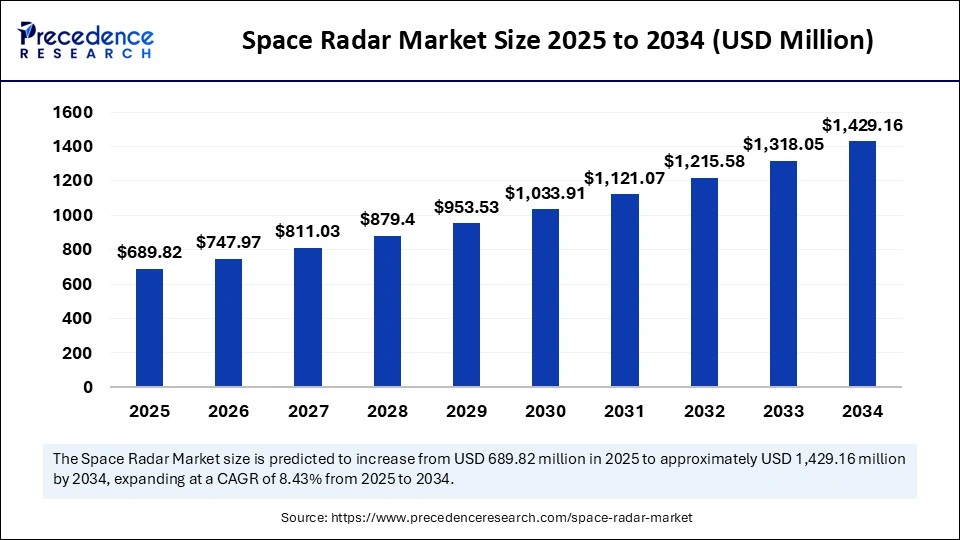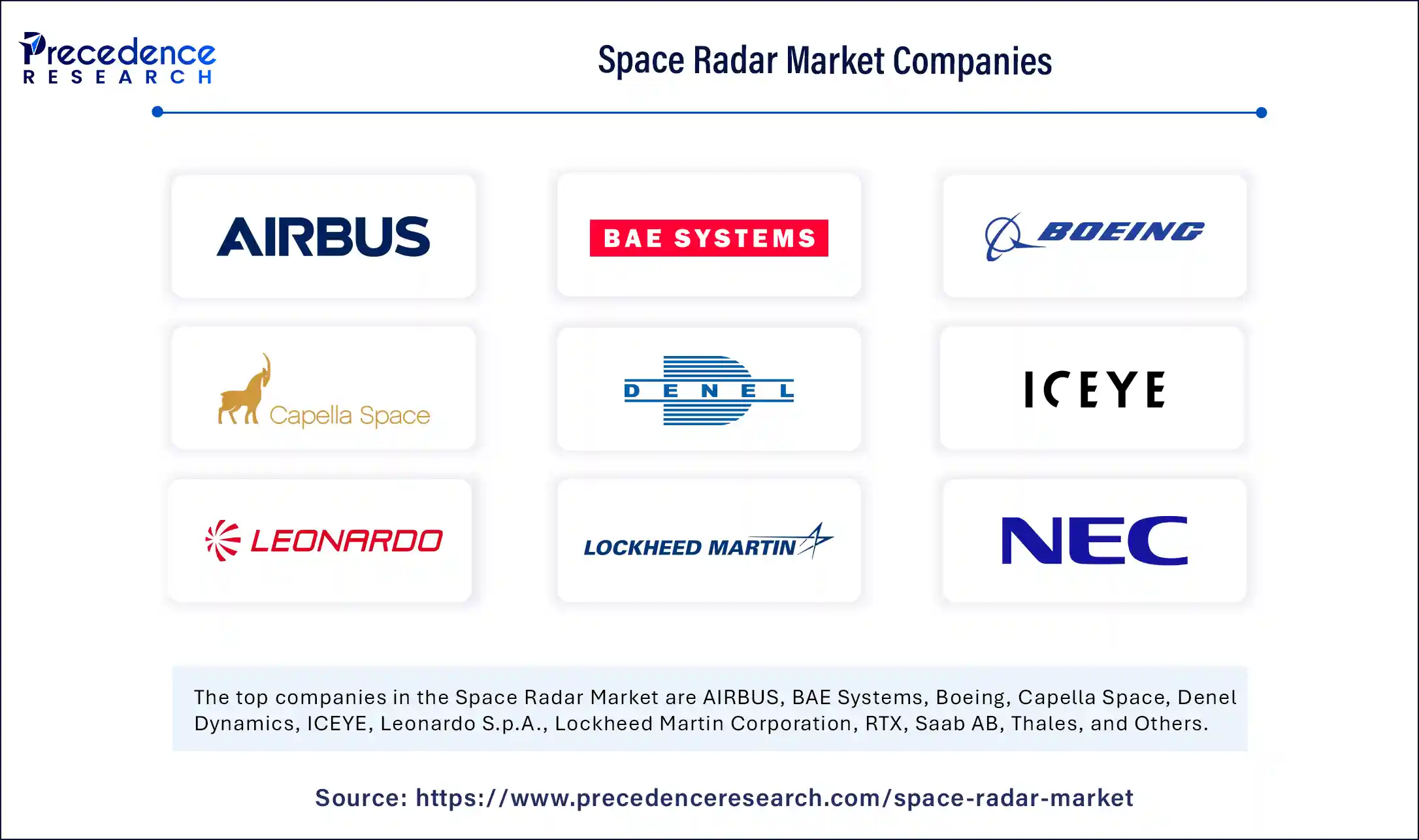
Space Radar Market Key Highlights
-
The global space radar market is estimated to be valued at $689.82 million in 2025, and it is projected to reach $1,429.16 million by 2034, growing at a CAGR of 8.43% during the forecast period.
-
North America led the market in 2024, holding the largest revenue share.
-
Asia Pacific is expected to register the fastest growth rate between 2025 and 2034.
-
By type, synthetic aperture radar (SAR) dominated the market with the highest share in 2024.
-
The Doppler radar segment is projected to witness the highest CAGR throughout the forecast period.
-
In terms of application, earth observation was the leading segment in 2024.
-
The weather forecasting segment is anticipated to grow at a significant pace in the coming years.
-
By platform, the satellite-based category held the major share in 2024.
-
The airborne platforms segment is expected to expand rapidly over the projection period.
-
Among frequency bands, the X-band segment generated the largest revenue in 2024.
-
The L-band segment is forecasted to grow at a notable CAGR from 2025 to 2034.
-
By end-user, the defense and security segment accounted for the highest share in 2024.
-
The government and commercial segment is projected to grow at the fastest CAGR during the forecast timeline.
Market Overview
The space radar market encompasses advanced radar systems employed aboard satellites and high-altitude aircraft to deliver all-weather, day‑and‑night surveillance and imaging. These systems—like Synthetic Aperture Radar (SAR) and Real‑Aperture Radar—are crucial for defense, environmental monitoring, disaster response, maritime tracking, and agriculture. As demand for high-resolution Earth observation grows, the market continues to expand.
Role of AI in the Space Radar Market
Artificial intelligence is integral to extracting actionable intelligence from space radar data. AI-powered algorithms enable automated image processing, anomaly detection, and object classification—such as identifying ships, vehicles, or deforestation. Machine learning enhances change‑detection capabilities, alerting users to new infrastructure or environmental shifts.
AI also enables on‑board data processing—reducing the need to downlink large volumes by prioritizing relevant insights—significantly cutting bandwidth and latency. As space radar moves toward real-time analytics, AI will be critical for managing multi‑constellation data fusion and delivering intelligence-on‑demand to operational users.
Growth Factors
Several key factors are accelerating the space radar market’s growth. First, national security concerns and defense modernization are motivating governments to deploy more radar-equipped satellites for continuous surveillance. Second, the increasing severity and frequency of natural disasters like wildfires, hurricanes, and floods have intensified demand for near‑real‑time all‑weather Earth observation.
Additionally, the rise of maritime domain awareness initiatives—tracking illegal fishing and supply chain monitoring—requires reliable radar imaging unaffected by cloud cover. Commercial sectors, including agriculture, oil & gas, and infrastructure planning, also increasingly rely on space radar for precision applications. Combined with declining launch costs and smaller satellite platforms, these forces propel rapid market expansion.
Market Scope
| Report Coverage | Details |
| Market Size by 2034 | USD 1,429.16 Million |
| Market Size in 2025 | USD 689.82 Million |
| Market Size in 2024 | USD 636.19 Million |
| Market Growth Rate from 2025 to 2034 | CAGR of 8.43% |
| Dominating Region | North America |
| Fastest Growing Region | Asia Pacific |
| Base Year | 2024 |
| Forecast Period | 2025 to 2034 |
| Segments Covered | Type, Application, Platform, Frequency Band, End User, and Region |
| Regions Covered | North America, Europe, Asia-Pacific, Latin America, and Middle East & Africa |
Market Drivers
Defense investments remain a primary driver, with nations seeking persistent surveillance capabilities for border monitoring and target detection. Environmental agencies are using space radar for climate data, glacial monitoring, and disaster mapping. Commercial adoption is growing as sectors like agriculture and infrastructure rely on radar data to improve planning and investment decisions.
Satellite technology advances, such as miniaturized systems (CubeSats) and micro-satellites, reduce entry barriers and allow faster, scalable deployments. Moreover, global cooperation and radar data-sharing initiatives contribute to greater adoption and accessibility.
Market Opportunities
Key opportunities lie in satellite constellation programs delivering rapid revisit rates for global monitoring. Services combining radar imagery with analytics—such as subsidence detection or oil spill monitoring—are in high demand. Integration with 5G networks and edge computing also enables real-time alerts to field operators.
Expanding markets like Asia-Pacific and Latin America represent strong potential as governments invest in disaster resilience and precision agriculture. Mergers between radar providers and AI/analytics firms can create comprehensive end-to-end intelligence services.
Market Challenges
Despite its promise, the market faces obstacles. Space radar systems are complex and expensive to develop, integrate, and launch. Signal processing demands robust ground infrastructure, and securing spectrum segments across countries can be regulatory hurdles. Data privacy and security concerns emerge when radar data can capture vehicle or vessel movement, leading to demand for anonymization and compliance standards.
Regional Outlook
North America
North America leads with strong defense budgets, large-scale satellite programs, and private sector involvement in Earth observation startups and analytics platforms.
Europe
Europe hosts major programs like ESA’s Copernicus Sentinel‑1 and national SAR missions, as well as active defense radar initiatives.
Asia-Pacific
Asia-Pacific is a fast-growing market, with nations like China, India, Japan, and South Korea launching domestic radar satellites and investing in analytics for agriculture and disaster response.
Latin America
Latin America’s adoption is emerging through partnerships for ground monitoring, forest management, and anti-illicit trade applications.
Middle East & Africa
These regions are investing in radar data for border security, water resource monitoring, and climate resilience. Growth is slower but steady, driven by regional safety priorities.
Competitive Landscape
The space radar market is competitive and includes satellite manufacturers, defense primes, and analytics providers. Major players include:

- AIRBUS
- BAE Systems
- Boeing
- Capella Space
- Denel Dynamics
- ICEYE
- Leonardo S.p.A.
- Lockheed Martin Corporation
- NEC Corporation
- Northrop Grumman
- RTX
- Saab AB
- Thales
These players focus on deploying new satellite constellations, AI analytics, and radar service platforms. Strategic partnership and defense contracts are shaping market dominance.
Future Outlook and Trends
The future will feature dense radar satellite constellations delivering frequent imagery, with small satellite swarms further reducing latency. Technology trends include ultra-wideband radar, multimodal sensors combining radar, optical, and thermal imaging, and quantum radar research.
AI-driven data platforms providing actionable insights—rather than raw images—will be a key differentiator. Usage will expand in emerging areas like space traffic management, on-orbit monitoring, and lunar/martian reconnaissance as deep-space missions arise. As radar capabilities democratize, expect increasing commercial usage.
Segments covered in the report
By Type
- Synthetic Aperture Radar
- Doppler Radar
By Application
- Earth Observation
- Weather Forecasting
- Disaster Management
- Others
By Platform
- Satellite-Based
- Airborne Platforms
By Frequency Band
- X-Band (8-12 GHz)
- C-Band (4-8 GHz)
- L-Band (1-2 GHz)
- Ku, Ka, and V Bands
By End User
- Defense and Security
- Government and Commercial
By Region
- North America
- Europe
- Asia Pacific
- Latin America
- Middle East and Africa
Also Read: Rare Earth Minerals Market
Get this report to explore global market size, share, CAGR, and trends, featuring detailed segmental analysis and an insightful competitive landscape overview @ https://www.precedenceresearch.com/sample/6221
You can place an order or ask any questions, please feel free to contact at sales@precedenceresearch.com|+1 804 441 9344